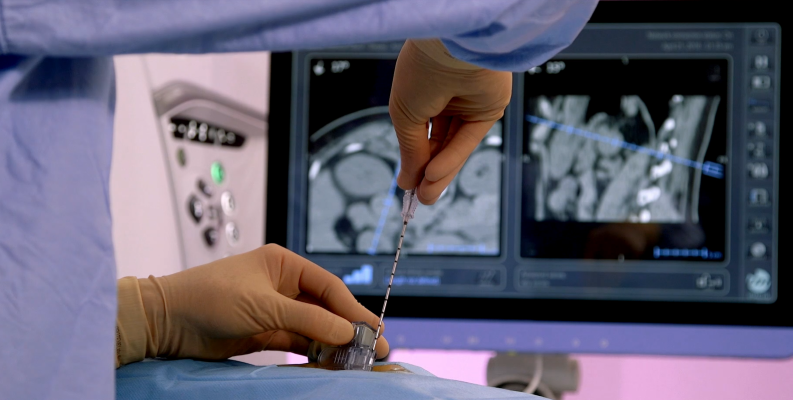
April 21, 2023 — GE HealthCare is further advancing its precision care strategy with CT-Navigation, which offers clinicians detailed, real-time, 3D computed tomography (CT) images for stereotactic needle guidance across an array of care areas, including interventional and oncological procedures as well as biopsies, ablations, drainage, therapeutics and more.
Interventional radiology – and specifically interventional CT – plays a key role in the diagnosis and treatment of disease. Providing highly detailed images of internal structures – such as bones, organs, and tumors – CT-guided interventions can assist clinicians in performing minimally invasive procedures that guide stereotactic needles through the anatomy to biopsy or deliver treatment directly to affected tissue. As a result, interventionalists benefit from greater visibility and confidence in needle placement, while patients benefit from more accurate and precise care.
“Consistent and accurate ‘navigation’ through the body is key in delivering precision care,” explains Prof. Laura Crocetti, associate professor of Radiology, Division of Interventional Radiology, University of Pisa in Italy and deputy chairperson of the European Conference on Interventional Oncology (ECIO)i. “CT-Navigation is an intuitive technology that helps us achieve this by enabling clinicians to select and follow an out-of-plane trajectory for a safer path that avoids critical organs and reaches deep-located targets with impressive accuracy, while reducing procedure time and possibly radiation dose. Altogether, it helps us ensure better patient outcomes while expanding the boundaries of our practice."
While many of today’s CT-guided solutions require that interventionalists take multiple control scans and awkwardly position themselves and the needle inside the gantry of a CT system – increasing the risk of radiation exposure to the clinician – CT-Navigation enables a more comfortable and safe experience. Instead of working wholly within the CT system’s narrow bore, interventionalists using CT-Navigation can simply place a sensor on the patient inside the gantry. After scans are complete and the patient is removed from inside the system, interventionalists have full range of motion while navigating a needle more easily and safely through the patient’s anatomy using the placed sensor and detailed CT images.
“To achieve precision care, we must provide clinicians with the tools and insights they need to deliver the right treatment, at the right time, to the right patient,” explains Jean-Luc Procaccini, president & CEO, Molecular Imaging & Computed Tomography, GE HealthCare. “CT-Navigation does just that – acting as an anatomical GPS for interventionalists to use and care for patients with increased ease and accuracy. We are thrilled to now increase global access to this innovative solution and its many clinical benefits to healthcare systems around the world.”
CT-Navigation was developed by IMACTIS and became part of the GE HealthCare portfolio of solutions upon close of the previously announced acquisition of the France-based company.
It is the result of more than a decade spent studying provider needs and designing a navigation system to improve safety, increase accuracy, and enhance the intervention workflow. The result is interactive imaging that enables:
- Improved intervention planning – The system is designed to show interventionalists the anticipated trajectory of their needles when they plan their intervention and help them select the best approach. It allows anatomical exploration and planning, while being in the room, close to the patient, using real-time images computed by the system, and can help reach the target and avoid critical structures and organs. Some users have experienced up to a 50% reduction in procedure timeii,iii.
- Precision care – The system also provides interventionalists with real time 3D navigation during the intervention, allowing them to work faster and with greater precision as well as providing the information they need to deal with complex situations – like out-of-axial plane trajectory – and reduce the number of control scans which can potentially reduce dose to patients and interventionists.
- Reduced variability – The workflow is simple, easy to learn, and works to reduce variability for simple and complex procedures and helps to improve reproducibility – a significant need reported by clinicians today. New users’ report that the learning curve is as low as only six to seven cases before gaining comfort with and confidence in the technologyiv,iii.
CT-Navigation – which includes a mobile workstation, guidance software, and disposable procedure kit – is approved under the European Union’s Medical Devices Regulation (MDR) and has FDA clearance for use within the U.S. GE HealthCare is a leader in CT with a large install base and global scale, which provides significant opportunities for the adoption of CT-Navigation and enhanced practice of precision care at existing client sites.
Today, the innovative solution focuses solely on CT applications, but GE HealthCare plans to expand the technology to its image guided therapy (IGT) business in the near future – further advancing its clinical application and reach.
For more information : IMACTIS.com
References:
i Not a consultant for GEHC: The statements by GE’s customers described here are based on their own opinions and on results that were achieved in the customer’s unique setting. Since there is no “typical” hospital and many variables exist, i.e. hospital size, case mix, etc. there can be no guarantee that other customers will achieve the same results.
ii C. Teriitehau, H. Rabeh, E. Pessis, Q. Sénéchal, F. Besse and M. Bravetti. (2020). Reduction of patient radiation dose during percutaneous CT vertebroplasty: Impact of a new computer-assisted navigation (CAN) system. (Volume 55, Number 1). Radioprotection. https://doi.org/10.1051/radiopro/2019049
iii As each hospital is unique, results may vary. GE Healthcare does not guarantee the results identified herein.
iv Based on an IMACTIS internal survey of 63 users in 2022. Data on file.


 December 05, 2025
December 05, 2025 









